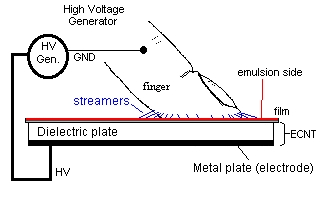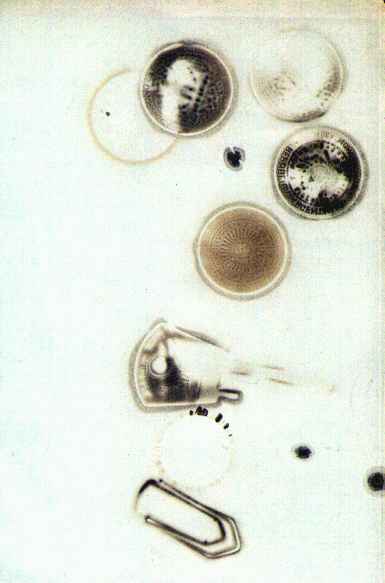

Intro

In classic contact electrophotography we have the object in contact with the emulsion. The film rests on a thin dielectric surface, which separates the film and the metallic electrode. A high voltage (> 10 KVolt) and low/medium frequency (LF/ MF < 1 MHz) generator is connected: HV generator output to active lower metal electrode and (optional) the return path ground connection (GND) to the specimen.

A corona discharge appears between the object and the electrode, jumping from the finger contour to the ECNT surface . The film registers this discharge by direct contact.
Film Structure
In order to study the images obtained by contact electrophotography, it's necessary to know how a color print film is constructed and to understand the photochemical process theory involved. A color print film is basically composed of several layers of different chromatic response. Each one of these emulsion layers containing silver halides crystals (usually silver bromide, Ag+Br-) is applied over a supporting medium. Also, some sensitivity specks of silver sulfide (Ag2S) which will attract free electrons and silver ions, are present.
The general arrangement of this multiple layer emulsion system is depicted below:

Basics of Photosensibilization
Initially, when a photon strikes a silver bromide ion, it kicks off the electron it was carrying, thus enabling this electron to travel free through the halide crystal. This wandering lasts until this free electron finds a sensitivity speck and bounds itself to it. Now, as more photons strike more silver bromide ions, new free electrons bound to this (or different) specks. As this speck is negatively charged, it attracts free silver ions (the ones that aren't locked into the halide crystal structure). When several silver ions are definitely bounded to one speck we have what in terms of photography is called a latent image.
Thus we may simplify the process by saying that what has happened was the photoreduction of Ag+ into metallic Ag0. The developing process is nothing more than the elimination of all silver ions from the emulsion; only the ones that were affected will remain. The exposed metallic silver crystals may now be replaced by the appropriate colored dye. Certainly, the practical developing process is far more complex than this simple description, as we may see in the next chapter.
Color Response and Developing
As we have said, the three main color sensitive layers have particular characteristics. The Green sensitive layer is an emulsion of the orthochromatic type, and the Red sensitive layer is panchromatic. Each one of this layers has its own exposure latitude, which, under the particular conditions present in electrophotography (low-light and high contrasts) is a very important factor when we must choose what type of film we should use. This factor it's also important when we make comparisons between two photographs taken with different kinds of film. Other important factors to analyze for each layer are: Spectral Sensitivity Curves, Spectral Dye Density Curves and obviously, the Characteristic Curve. Also, as in contact electrophotography, objects are of reduced dimensions, the Resolving Power (for a given chart contrast) in lines per millimeter, is another factor to consider.

After taking the photographs we need to develop the film, in this process, latent images in each layer are colored with dyes with the complementary color of that layer, in order to obtain the color negative. Therefore, the complementary color for each layer is:
| Layer | Color Dye |
| BLUE | YELLOW |
| GREEN | MAGENTA |
| RED | CYAN |
This color substitution is made because we will use the subtractive color synthesis i.e.: colors are formed by subtraction of certain colors from white light. As the color print paper on which we will project the color negative images has similar layer structure, original color restoration may be accomplished when white light strikes the complementary color dyes of the paper, thus:
White - Yellow = BLUE
White - Magenta = GREEN
White - Cyan = RED
This developing process is very complex as many operations need to be performed and, as we have seen, it's standardized, which means that dye proportions, developing time, bath temperature, etc, are fixed inputs for a particular type of film (Manufacturer-ISO number-type-Slide/Color Print). These fixed parameters assume you have exposed your film in a conventional way, thus assuring perfect color reproduction. When we employ the film under different circumstances from the ones that were initially intended, and apply the same developing techniques and standards, we can't be sure that the developing process is the correct one for this particular application.
Contact photography introduces many variables absolutely not present in conventional photography. Further we may classify these aspects in:
Optical & Electrical Variables
 |
|
As typical electrical discharges produce ultraviolet light, all kinds of images may be formed on the film due to this uv radiation. If we remember that all kind of precautions taken against UV light (filters) when we take conventional photos in order to prevent haziness, halos and whitish pictures, what can be said when we expose the film to directly uv light? Although common optical glass it's not very transparent to uv radiation, all kind of filters are used (Skylight or even specific UV filters) to prevent uv radiation from reaching the film; let's consider then what direct uv illumination may produce!
 |
|
Photointegration of different streamers occurring at different moments may induce to think that both streamers were present simultaneously at the time of the exposure. If opposing surfaces fires streamers simultaneously, certainly electrical repulsion effects between them should be observed, but if they are fired with different timing, no repulsion effect will be observed in the photo and obviously one will be driven to conclude that electrical laws are not working at this time..., conclusion that certainly is not true. To prevent this, ultrafast motion movies should be employed in order to register different streamer firing moments. For all I know, surprisingly, no one has performed this kind of experiments yet.
Another point is related to the fact that, as
electrophotography images are formed from a general low intensity light source
but with particular high intensity spots, we won't be
working on the right part of the Characteristic Curve of the
emulsion, i.e.: the linear zone.
In the subexposition zone, low
light events will not be registered properly; in the overexposition zone, the
latent image will no longer be directly proportional to the intensity of
impinging light.
Lack of proper surface flatness will
certainly modify image contrast and resolution.
It must be remembered that we are not projecting an image
onto the film!, only very close proximity between streamers and
emulsion will assure a defined image, the rest of impinging light will create
halos and undefined forms, spots and general haziness.
Chemical & Mechanical
Emulsion contamination is one of the greatest nightmares of film processing labs, for they may introduce all kinds of false images! When making contact electrophotography, this particular source of false images is working in a very effective manner. Finger sweat with all kinds of solid contaminant and solutions of water with body substances, salts, fat and God knows what, may deposit and interact with the emulsion thus modifying its chemical properties also inducing specific electrical conductive properties that will modify "normal discharge paths" over clean surfaces.
 |
|
It has been observed that high intensity streamers, i.e.: discharge channels were rapidly moving electrons collide with air molecules (mainly Nitrogen), produce ozone and oxygenated nitrogen compounds, all with high chemical reactivity that may interact with the emulsion.
Also, in these high intensity streamers we have a high-speed particle flow (electrons and gaseous ions). It has been observed that this flow has a remarkable capacity to erode soft surfaces, for example acrylic, leaving an excavated "positive" image of the object, with depths of several hundred microns. With this fact in mind and considering that before developing the film, erosion marks on the emulsion have been observed (even at naked eye), one may ask about the consequences that this kind of electroerosion may have over the emulsion layer system, where each layer has only a few microns!
Summary
It may be useful for the researcher to contact the film manufacturer and ask what he thinks about this unconventional application of his product, perhaps the points I've mentioned above will be better understood by many researchers and certainly, when questioned about the mentioned issues, will not ask: What are you talking about?
For me it's very impressive the lack of knowledge about photography shown by all researchers of Kirlian Photography. If you work with unusual photographic images, at least it's expected that you know something about this issue. How a realistic research may be initiated if one can't classify and understand how any image was formed? All red spots are red because there was a red light? That particular bright colored spot, was really present when the film was exposed? Questions like these should be answered from a scientific point of view, using all present (and past) available knowledge, otherwise the research in this area will certainly not be considered as "scientific research", just one more case of mumbo-jumbo pseudo- science.